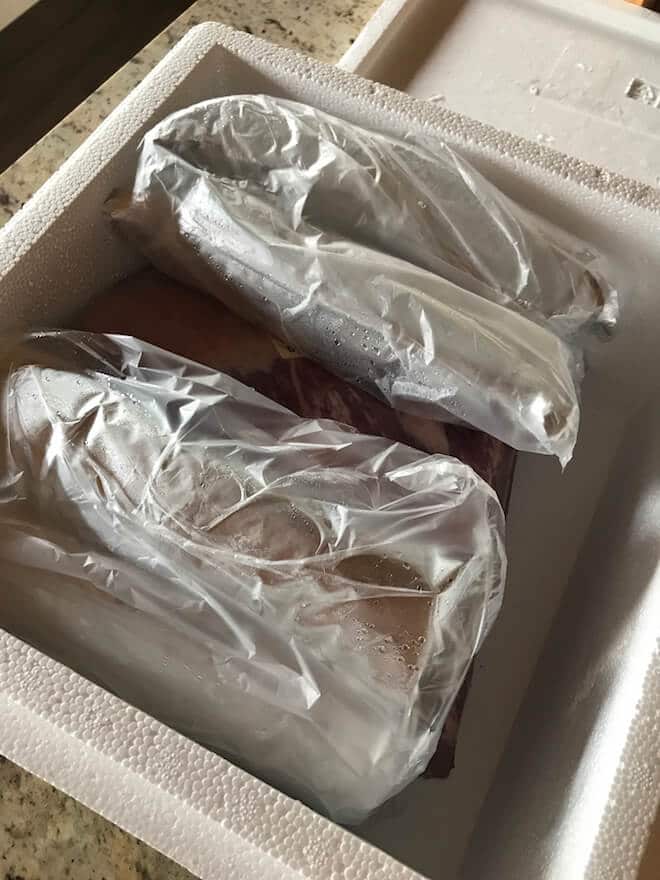Cool grilled meat perfectly
Food is not indefinitely durable, as we all know. Fish and poultry are particularly susceptible when it comes to improper cooling of grilled meat. Nowadays, refrigerators are found in practically every kitchen, aimed at prolonging the shelf life of food as much as possible. Refrigerators have been around since about 1920. This quickly raises the question of how people stored their food before that. The history of cooling grilled meat goes far back. Once again, the clever Chinese (who also ensured that New Year’s Eve is not a quiet celebration) were already cooling their food with ice blocks 3,000 years ago. Although they may not have known it precisely, it was already noticed back then that cold reduces the decay process, reduces harmful bacteria, and inhibits the food’s own enzymes, thus keeping meat or fish fresh for longer. Ice blocks were even a commodity in the Mediterranean region for a long time. Cold caves were also used as storage spaces. Households that had to wait for the invention of the refrigerator used the cool cellar as a storage space.

Cooling Grilled Meat Today
Today, no one hauls ice blocks around for their food anymore, perhaps with one exception we’ll come to later. Modern refrigerators (compressor refrigerators, absorber refrigerators, or refrigerators with Peltier elements) can cool grilled meat without the need for ice. They usually work electrically (there are also refrigerators that function with fuels) and automatically regulate the set temperature. The usual temperatures of household refrigerators range from 2 to 8°C. Many refrigerators even have different temperature zones, such as the vegetable compartment. Therefore, anyone who wants to cool grilled meat should also pay attention to where they place it in the refrigerator. Although refrigerators are among the highest electricity consumers in households (they work almost around the clock), there are now very efficient devices – recognizable by the EU energy label. Modern cooling techniques combined with good insulation are a prerequisite for this, even for freezers or chest freezers.
Tip: If you want to grill in the great outdoors, you’ll usually find no power outlet. Even today, ice blocks can still be purchased. With them, for example, a larger cooler, ideally insulated, can maintain refrigerator temperatures for up to 12 hours. In a garden plot without electricity, an old refrigerator can also be well cooled with ice blocks.
Cooling Pack for MeatGrilling Meat without a Refrigerator
Nowadays, a refrigerator is not the panacea, because when food is taken out of the store’s cooling chain, it should also be kept cool during transport and storage. Since grilling mostly takes place in summer and vehicles also heat up significantly in summer, it’s not so easy to maintain the cooling chain. Simply putting meat or other perishable foods in a bag in the trunk, which is also rarely cooled by the car’s air conditioning, is not a good idea. But even inside the vehicle, hardly anyone will generate refrigerator temperatures with their air conditioning. So, the aim is to isolate the food from the ambient temperature. For this purpose, special thermal bags are available in almost every supermarket. They are sufficient to isolate the food for short-term transport. With rising outside temperatures, however, the protective bags quickly reach their limits. A cooler box, equipped with pre-cooled cooling packs, withstands higher outside temperatures much better. There are also electric coolers for the car, which, however, draw a lot of energy from the car battery when stationary. If you have a weak or already old car battery, you should refrain from using it, as the vehicle may then not start. Cool boxes with cooling packs are not only practical for transporting groceries from the store to home but can also cool the grilled meat or keep the drinks cold at the barbecue site. Since they operate without electricity, the presence of a power outlet also doesn’t matter.
Distribution of Cold in the Refrigerator
As mentioned earlier, a refrigerator has different temperature zones. Due to static cooling (without ventilation), cold air descends from the evaporator at the back of the refrigerator into the refrigerator, while warmer air rises upwards. So theoretically, the lowest point in the refrigerator would also be the coldest. However, most refrigerators have a separate vegetable compartment at their lowest point, often covered with a glass pane. This represents an insulated zone in the refrigerator where it is not as cold as in the rest of the refrigerator. Not all foods are robust enough or react sensitively to cold, for example, fruits or vegetables should be placed accordingly in the vegetable compartment.
The coldest spot in a refrigerator is above the vegetable compartment. Here, it is on average 5°C, ideal for cooling grilled meat. Sausage products are also well placed here.
Above that, it’s slightly warmer, around 6°C. Dairy products should be placed here. In the lower part of the refrigerator door, temperatures are also usually around 6°C, ideal for cool drinks.
At 8°C, prepared dishes, smoked sausage or meat products, as well as cheese, can find storage space.
Similar to the upper part of the refrigerator door, the vegetable compartment has temperatures of 9 to 10°C. Butter, eggs, mayonnaise, ketchup, etc., find their place here.
Of course, temperatures may vary depending on the owner’s settings or different refrigerator models.
Besides the grilled meat, the beer should also be kept cool: here’s my Napoleon Prestige Pro 825 grill with a beer cooling compartment.
Shelf Life of Raw Meat in the Refrigerator
In general, the cold chain should not be interrupted when cooling grilled meat. It should be ensured that temperatures do not exceed 7°C even during transport. Therefore, transportation from the store to the refrigerator should not take longer than 20 minutes. A storage temperature of only 4°C is recommended. This corresponds to the lowest point of the refrigerator; if necessary, additional lowering may be useful. Simply place a thermometer at the lowest point of the refrigerator.
The shelf life also depends on the type of meat and its surface. The larger the surface area, the faster bacteria can penetrate the meat. Large surface areas include minced meat, sliced meat, or goulash. The following list gives you some guidelines on how long you can keep meat:
Prepare on the same day: Raw minced meat
Raw poultry: 1 to 2 days
Raw goulash or sliced meat: 1 day
Raw offal: 1 day
Cooked or boiled sausage: 2 to 4 days
Whole roasts or steak pieces: 3 to 4 days
Already cooked meat: 2 to 3 days
If you shop less frequently but still want to have a stock of meat, you can also freeze it. Bacteria or fungi cease their activity at temperatures around minus 18°C. However, fat can become rancid, so the fat content of the respective meat determines the storage time:
Frozen at minus 18°C, the shelf life is:
Minced meat with a high fat content: 1 month
Lean minced meat: 1 to 3 months
Pork with a high fat content: 4 months
Lean pork: 6 to
8 months
Chicken: 8 to 10 months
Veal: 9 to 12 months
Beef: 10 to 12 months
Once frozen meat is thawed, bacteria reappear. Therefore, meat should be thawed slowly in the refrigerator. It must then have no contact with other raw foods in the refrigerator, which are also eaten raw, nor with the thawing water. This is particularly important for pork and poultry due to possible salmonella contamination.
Pay Attention When Shopping!
The fresher the meat, the longer it lasts and the better it tastes. Therefore, when buying packaged meat, pay attention to the best-before date. Also, the packaging should not be damaged or have air pockets. Spoiled meat can be recognized by color, smell, appearance, consistency, or taste. Causes of spoiled meat are often interruption of the cold chain, poor hygiene, freezer burn (dehydration), contamination, or parasite infestation.
It is strongly advisable to refrain from consuming spoiled meat, as it can cause many discomforts, from nausea, diarrhea, vomiting to severe food infections. It’s better to play it safe and refrain from consuming it if in doubt. Ideally, don’t buy it in the first place if you have doubts; then there won’t be any problem with cooling grilled meat. If you know a good butcher, you can of course also buy there. As a rule, butchers know when the animal was slaughtered, where it came from, and how it was kept.
What Does Good Meat Look Like?
First of all, it should be mentioned that not every meat can be seen whether it is contaminated with bacteria. In any case, the following points should be correct:
The color is usually the first thing a buyer notices about meat. Pork is shiny and light pink. Beef ranges from light to dark red when fresh. Game has a darker red to reddish-brown color. The age of the animals also plays a role. The younger the animal, the lighter its meat. Unfortunately, some lighting in the displays significantly alters the color of meat, making it look more appetizing.
Grilled Meat in the Refrigerator
The surface texture of raw meat should not have pressure marks or be greasy. Fresh meat is firm and should not give way too much to finger pressure. Fresh meat does not lose much water. If it practically floats in its own juice, it is already older.
Meat should not smell sweet or unpleasant. Fresh meat smells neutral to mild or slightly sour.
The marbling is practically the fat marbling between the individual muscle fibers. Meat with a stronger marbling also has a higher fat content. Fat is an important flavor carrier. Fresh meat has white marbling. With increasing age of the meat, it changes color to yellow to dark yellow.
Conclusion
Properly cooling grilled meat starts with shopping. Meat should be purchased last. It should be transported in insulated shopping bags that must be closed or, better yet, in cool boxes with pre-cooled cooling packs. The transport from shopping to the refrigerator should not take longer than 20 minutes. If you don’t trust discounters, you can of course also shop at the butcher’s. Here, the price is usually higher, but the quality and freshness are often better. Hygiene is important when handling raw meat, not only during storage. Special care should be taken with minced meat, pork, and poultry. If you heed our advice and cool grilled meat properly, you won’t have to worry about grilling.



